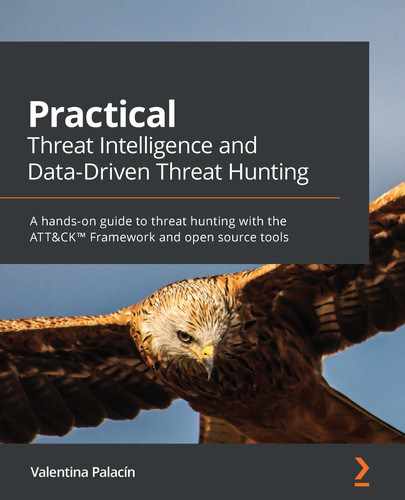Get to grips with cyber threat intelligence and data-driven threat hunting while exploring expert tips and techniques Threat hunting (TH) provides cybersecurity analysts and enterprises with the opportunity to proactively defend themselves by getting ahead of threats before they can cause major damage to their business. This book is not only an introduction for those who don't know much about the cyber threat intelligence (CTI) and TH world, but also a guide for those with more advanced knowledge of other cybersecurity fields who are looking to implement a TH program from scratch. You will start by exploring what threat intelligence is and how it can be used to detect and prevent cyber threats. As you progress, you'll learn how to collect data, along with understanding it by developing data models. The book will also show you how to set up an environment for TH using open source tools. Later, you will focus on how to plan a hunt with practical examples, before going on to explore the MITRE ATT&CK framework. By the end of this book, you'll have the skills you need to be able to carry out effective hunts in your own environment. If you are looking to start out in the cyber intelligence and threat hunting domains and want to know more about how to implement a threat hunting division with open-source tools, then this cyber threat intelligence book is for you.Key Features
Book Description
What you will learn
Who this book is for
Table of Contents
- Practical Threat Intelligence and Data-Driven Threat Hunting
- Why subscribe?
- Contributors
- About the author
- About the reviewers
- Packt is searching for authors like you
- Preface
- Section 1: Cyber Threat Intelligence
- Chapter 1: What Is Cyber Threat Intelligence?
- Cyber threat intelligence
- Strategic level
- Operational level
- Tactical level
- The intelligence cycle
- Planning and targeting
- Preparation and collection
- Processing and exploitation
- Analysis and production
- Dissemination and integration
- Evaluation and feedback
- Defining your IR
- The collection process
- Indicators of compromise
- Understanding malware
- Using public sources for collection – OSINT
- Honeypots
- Malware analysis and sandboxing
- Processing and exploitation
- The Cyber Kill Chain®
- Bias and analysis
- Summary
- Chapter 2: What Is Threat Hunting?
- Technical requirements
- What is threat hunting?
- Types of threat hunts
- The threat hunter skill set
- The Pyramid of Pain
- The Threat Hunting Maturity Model
- Determining our maturity model
- The threat hunting process
- The Threat Hunting Loop
- Threat hunting model
- The data-driven methodology
- TaHiTI – Targeted Hunting Integrating Threat Intelligence
- Building a hypothesis
- Summary
- Chapter 3: Where Does the Data Come From?
- Section 2: Understanding the Adversary
- Chapter 4: Mapping the Adversary
- Chapter 5: Working with Data
- Chapter 6: Emulating the Adversary
- Section 3: Working with a Research Environment
- Chapter 7: Creating a Research Environment
- Technical requirements
- Setting up a research environment
- Installing VMware ESXI
- Creating our VLAN
- Configuring the firewall
- Installing Windows Server
- Configuring Windows Server as a domain controller
- Understanding the structure of Active Directory
- Giving the server's domain controller a status
- Configuring the DHCP server
- Creating organizational units
- Creating users
- Creating groups
- Group Policy Objects
- Setting up our audit policy
- Adding new clients
- Setting up ELK
- Configuring Sysmon
- Retrieving the certificate
- Configuring Winlogbeat
- Looking for our data in the ELK instance
- Bonus – adding Mordor datasets to our ELK instance
- The HELK – an open source tool by Roberto Rodriguez
- Getting started with the HELK
- Chapter 8: How to Query the Data
- Technical requirements
- Atomic hunting with Atomic Red Team
- The Atomic Red Team testing cycle
- Testing for Initial Access
- Testing for Execution
- Testing for Persistence
- Testing for Privilege Escalation
- Testing for Defense Evasion
- Testing for Discovery
- Testing for Command and Control
- Invoke-AtomicRedTeam
- Quasar RAT
- Quasar RAT real-world use cases
- Executing and detecting Quasar RAT
- Testing for persistence
- Testing for credential access
- Testing for lateral movement
- Summary
- Chapter 9: Hunting for the Adversary
- Chapter 10: Importance of Documenting and Automating the Process
- Section 4: Communicating to Succeed
- Chapter 11: Assessing Data Quality
- Chapter 12: Understanding the Output
- Chapter 13: Defining Good Metrics to Track Success
- Chapter 14: Engaging the Response Team and Communicating the Result to Executives
- Appendix – The State of the Hunt
- Other Books You May Enjoy
